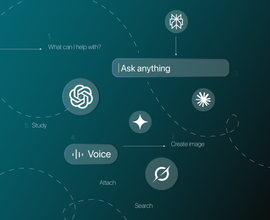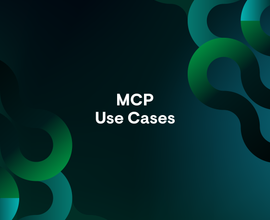How to Scale AI Content Generation for AEO / GEO
Quality AI content isn't about finding the perfect prompt—it's about the preparation you do before you ever start writing. The brands creating standout content at scale aren't relying on one-sentence instructions to ChatGPT. They're organizing their data upfront, loading comprehensive brand context into their tools, and injecting authentic personality into every piece they produce.
This requires a fundamental mindset shift: treating content preparation as the competitive advantage, not the content generation itself. If you're still starting with a blank page and hoping AI will figure out your brand voice, you're missing the strategic foundation that makes speed possible.
Everyone has access to ChatGPT. Not everyone creates content that drives results.
At C3 2025, New York’s premier AEO / GEO conference, brought to you by Conductor, Christine Kayser, SEO and Content Strategist, and Sam Billetdeaux, Principal Product Manager at Conductor, walked through how enterprise teams are leveraging Conductor's AI platform to accelerate their content production without sacrificing quality.
The challenge isn't generating more content faster. It's creating content that's genuinely high-quality, on-brand, and strategic—at the speed and scale that modern marketing demands. That means transforming your usage of AI from a generic content machine into a strategic asset that sounds like your brand.
Their framework centers on three essential steps, powered by Conductor's AI features:
- Do the prep work upfront: Organize data dashboards to know what content to prioritize, build detailed Content Profiles in Conductor that capture your brand voice and audience, and use Conductor's AI Topic Map to focus on opportunities where your brand has genuine authority instead of chasing random keywords.
- Work from templates, not blank pages: Start with strategic outlines and structured frameworks that guide your content creation.
- Inject personality into everything: Upload Knowledge Sources with your brand's institutional wisdom—webinar transcripts, product specs, SME interviews—to give AI access to what makes your perspective unique, then layer in the authentic voice that makes content memorable instead of forgettable.

Do the prep work: The foundation for quality at speed
Preparation is everything. The brands scaling content successfully aren't the ones with the cleverest prompts—they're the ones who've done the strategic work before writing a single word.
For content teams, this means having the right data and strategic frameworks in place before you start creating. It sounds counterintuitive: spending time on preparation seems to contradict the goal of creating content quickly. But that upfront investment pays dividends when you're working at scale.
To create content at speed, you actually have to do your homework first, which isn't super fun to think about, but really helps you do this on the fly later.
Think of it this way: every minute spent on strategic preparation saves you from scrambling mid-project, second-guessing your approach, or creating content that misses the mark entirely. This is where Conductor's data-driven approach becomes essential.
Data dashboards: Know what to create
Before you write a single word, you need to know what content to prioritize. It's easy to get caught up in the excitement of AI-powered content creation and start cranking out articles, but without data guiding your decisions, you're just guessing.
The solution is creating dedicated workspaces for each priority vertical with smart page groups and keywordKeyword
A keyword is what users write into a search engine when they want to find something specific.
Learn more groups that automatically update. This isn't just about organization—it's about having a single source of truth that constantly reflects what's working and what isn't.
With the right dashboards in place, you can:
- Determine whether to create net-new content or refresh existing pages
- Identify where you're succeeding and where you need help
- Prioritize content creation efforts based on real performance data
The result is strategic content creation instead of reactive content creation. You're not constantly wondering "what should I write about next?" The data tells you.
Content Profiles: The #1 way to sound like your brand
If you're going to invest time in one Conductor AI feature, make it Content Profiles. This is the difference between AI-generated content that sounds like it came from anywhere and content that sounds distinctly like your brand.
People ask me all the time, ‘What is the most important thing I could do, or what's the best way to actually get the highest quality content from Writing Assistant?’ [Content Profiles] is the number one way to have content actually sound like your brand and reflect something that's not just generic ChatGPT
Content Profiles feed detailed context into Conductor’s AI Writing Assistant—your target audience, brand voice, style guidelines, and examples of what does and doesn't sound like your brand. But here's where teams often get stuck: they stress over the formatting, trying to structure their brand guidelines in a way they think the AI will understand.
Our advice? Don't overthink it.
Context dump, don't worry about it being super formatted. That's what [Conductor's] job is with this system prompt—we take whatever you put in here and make use of it to give better outputs
The more context you provide in your Content Profiles, the better your results. Skip the formatting concerns and focus on giving the AI everything it needs to understand your brand. Copy and paste style guides, audience demographics, and examples of your best writing—the AI can handle it.
AI Topic Map: Focus on the right opportunities
Having the right tools means knowing where to focus your efforts, not just having the capability to create content. Conductor’s AI Topic Map feature shows you how AI visibility systems like search engines and ChatGPT view your site's authority, then recommends where to create or optimize content.
This shifts content strategy from opportunity-chasing to authority-building. Instead of targeting whatever keywords have high search volumeSearch Volume
Search volume refers to the number of search queries for a specific keyword in search engines such as Google.
Learn more, you're asking a more fundamental question about your brand. Topic Map helps by:
- Focusing on where your brand actually has authority, not random keywords
- Showing you opportunities to demonstrate expertise in areas you should own
- Helping answer: What do you have the right to be talking about?
The goal isn't chasing any keyword or prompt—it's building authority where it matters for your brand. This focus ensures that every piece of content you create reinforces what you want to be known for, rather than diluting your expertise across topics where you have no business playing.
Work from templates: Not blank pages
All too often, content teams waste hours writing in the wrong direction. They draft entire articles only to realize the structure doesn't work, the angle is off, or they're missing critical sections. Conductor’s AI Writing Assistant solves this by generating outlines first—giving you a complete content skeleton in seconds. Review it, adjust it, approve it. Then move to production knowing exactly where you're headed.
You can create [content] a lot faster by starting with an outline first, rather than writing a full draft and then using Writing Assistant to figure out if your draft is any good. When you start with an outline, you already know you're on the right track.
Think of outlines as quality control checkpoints. Before anyone spends time writing, before compliance reviews a word, before a freelancer bills hours—you've confirmed the content will hit the mark.
Use Content Score for direction, not perfection
Teams often ask: What's a good Content Score? Can I get to 100? But that's the wrong question.
Content Score isn't about chasing a perfect number. It's about understanding whether you should be working on a piece of content in the first place, and if so, what specific improvements will make it better. The purple AI response boxes provide those recommendations.
It's all about actionability and directionality over the just specific gamification of the numbers.
Let the Revise feature do the tedious work
Most teams overlook the Revise feature within Conductor’s Writing Assistant, but it's one of the most powerful tools for maintaining quality while working at speed.
Revise handles the tedious editing tasks that slow down content production—converting dense paragraphs into scannable bullet points, stripping out jargon, or rewriting technical sections in plain language. Teams in regulated industries find this particularly valuable because they can let AI handle the heavy lifting while maintaining full control over what actually changes.
Inject personality: The differentiator
Here's the problem with most AI-generated content: it's indistinguishable. You could swap one brand's AI-written article with another's and no one would notice the difference.
Without the brand POV, everything's kind of flat…[AI-generated content] doesn’t really have heart.
Personality is what transforms technically sound content into something that actually resonates. It's the difference between content people skim and content they remember.
Knowledge sources: Your brand’s institutional wisdom
Conductor's new Knowledge Sources feature lets you upload existing documentation—webinar transcripts, marketing studies, product specifications, SME interviews—directly into Writing Assistant. This gives AI access to what makes your brand unique without requiring you to create new materials from scratch.
Think about everything that contains what your business does, what your brand knows, what your authority is, what you can speak to with more expertise than generic ChatGPT.
The key insight: you don't need to create net-new documents. Leverage what already exists across your organization—in Slack, knowledge bases, technical documentation, sales materials, support tickets.
Instead of manually transcribing and analyzing all that expertise, you can now pull transcripts and upload them directly, giving the AI access to your brand's unique knowledge.
Every minute you put into that critical thinking upfront, it's going to pay back in the quality of the output you get.
Expertise still matters
With all the focus on AI, it's easy to think traditional SEO factors have become obsolete. Our take? They haven't. E-E-A-T principles still matter.
I'm surprised we haven't heard E-E-A-T [more] because it's still important. The basics of SEO are still important.
Include expert credentials on pages. Weave in quotes from your SMEs. Bring in information that only your brand can provide—especially in regulated industries, where AI systems have learned (sometimes the hard way) to be more careful about sourcing information.
In summary
Creating quality content at speed isn't about finding the perfect AEO / GEO tool or the right one-sentence prompt. It's about doing the homework upfront and giving AI the context it needs to produce work that actually sounds like your brand.
Everyone has access to the same AI tools. ChatGPT is available to anyone. What separates forgettable content from content that drives AI visibility is the preparation you invest and the brand context you provide.
The difference isn't just the technology—it's having a platform built for this strategic approach. Conductor gives you the framework to do the prep work that matters: organized data dashboards, comprehensive Content Profiles, and Knowledge Sources that capture your brand's unique expertise. Put in the effort upfront, and you can create content that's both fast and genuinely valuable.
Sam Billetdeaux and Christine Kayser shared these insights and more during their C3 2025 session, Creating Quality Content at Speed with Conductor: Take a Tour of Conductor Creator—watch the full recording below.
This article is based on insights shared at C3—New York’s premiere AEO / GEO conference—brought to you by Conductor, and has been adapted for clarity and depth.


![Sam Billetdeaux, Principal Product Manager, [object Object]](https://cdn.sanity.io/images/tkl0o0xu/production/7bff75b914a4c0ad0996a3fbb86c6850c3e1629f-379x379.jpg?fit=min&w=100&h=100&dpr=1&q=95)






